Dark Age of Camelot Preview
We've been playing the beta of Mythic's MMORPG, and we've got some early impressions and screenshots.
Virginia-based developer Mythic Entertainment has been making online multiplayer games for years, games like the text-based MUD (multi-user dungeon) role-playing game Darkness Falls: the Crusade and, more recently, the 1999 team-based first-person shooter Spellbinder: The Nexus Conflict. Mythic's next project is a massively multiplayer online role-playing game called Dark Age of Camelot. This game is loosely based on classical European mythology, and it takes place shortly after the fall of King Arthur and the dissolution of the Round Table.
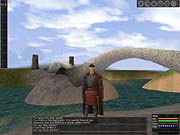
If you've played a graphical online role-playing game like Ultima Online, Asheron's Call, or EverQuest, you'll likely find Dark Age of Camelot's basic structure to be familiar. The game lets you create a character from a specific character race and class, and then lets you jump in and explore the game's virtual world, fight monsters, and gain experience points and levels. However, Dark Age of Camelot will have a number of distinctive features, not the least of which will be its mythological setting. The game's world consists of three realms: the Celtic land of Hibernia, the Nordic land of Midgard, and the British land of Albion. In the final version of the game, you'll be able to create characters of different races and character classes in each of the three realms with the immediate purpose of adventuring in your homeland and with the ultimate goal of invading either (or both) of the other realms. Dark Age of Camelot is currently in its second phase of closed beta testing, and the realm of Albion has already been implemented and is being explored (and exploited) by diligent beta testers.
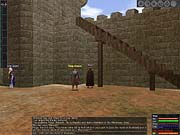
Even though King Arthur has perished, Albion is as lush and verdant as ever. It's a land of green fields and rolling hills, marked by winding roads and clear blue rivers. Albion is huge, but you won't run into any kind of transitional pauses as you travel through it. The entire realm is treated as a single area, so you can run from any one point in Albion to another without any loading time at all. Mythic has already implemented full day and night cycles into the game, and the high-quality, dynamic sky is as beautiful during the day as it is at night when the moon rises. Though it does tend to get somewhat dark at night, Mythic has insightfully given each character a personal torch, which casts more than enough real-time light to help your character find its way around.
The current edition of the beta already features all of Albion's character races and most of its character classes. Albion is home to four major character races: the stout, well-rounded Britons; the tall, slim Avalonians; the proud Highlanders; and the dusky Saracens. Dark Age of Camelot lets you customize your character's appearance by not only choosing your character's race and gender but also by choosing your character's height, hair color, and face. After you've created your character, you'll be able to further customize its appearance by choosing to wear different styles of armor, as well as by applying colored dyes to your character's clothing and armor. Though these options go a long way to help make your character look distinctive, none affects your character's actual abilities in the slightest.
Classes and Races
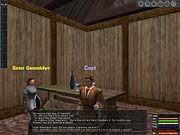
Dark Age of Camelot's characters have eight different ability scores: strength, dexterity, quickness, constitution, intelligence, piety, empathy, and charisma. Strength directly affects how much a character can carry as well as how much damage a character deals in combat with melee weapons, especially crushing weapons such as maces and hammers. Dexterity affects a character's proficiency with both thrusting weapons (such as daggers and rapiers) and bows; it is also tied to certain thieving skills and the defensive-evade skill. Quickness influences a character's attack speed in combat, both the speed at which a character swings a weapon and the speed with which that character recovers from the attack and becomes ready to swing again. Constitution determines how many health points a character has, and it also affects the rate at which a wounded character regains health while resting. Intelligence affects how much reserve spell power mages have as well as how quickly a mage regains spent spell power. Piety affects an acolyte's spell-power reserve and rate of recovery, while empathy is tied to the spell-power reserves and recovery rate of druid and shaman characters. The charisma score relates to the effectiveness of a bard's magical songs.
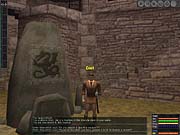
Each of Albion's different races has a slightly different basic ability score and begins its life in a different part of the realm. For instance, the Highlanders begin their lives with great strength and stamina but have poor reflexes, while the swift Saracens are just the converse. Avalonians aren't physically powerful, though they're naturally intelligent and make excellent mages, while Briton characters have middling ability scores across the board. Avalonians, Highlanders, and Saracens may choose to play as three of the four base character classes: fighter, rogue, mage, and acolyte, while Britons may choose to play as any of the four. Fighters are the most robust of the base classes, and they can use the heaviest armor and weapons, though they can use no magic. Rogues are swift characters who tend to wear lighter armor and favor daggers and light swords over heavier weapons. Mages are fledgling spellcasters with some minor combat magic, and acolytes are apprentice priests who possess minor healing and protection spells. Once you've chosen your character's race, class, and starting attributes, you can begin your character's adventuring career in Albion.
Despite the many choices that are already available in this stage of the beta test, much of Dark Age of Camelot's gameplay and structure is surprisingly well balanced. What few gameplay and character imbalances that the beta testers have unearthed have either already been addressed, or they are under careful scrutiny and will be addressed soon by Mythic's vigilant staff of producers, programmers, and designers, who frequent the beta testers' discussion area.
Gameplay
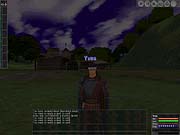
Mythic has already implemented a number of innovative solutions to the problems that plague online role-playing games. For instance, the game's economy, while currently more than a little tightfisted (especially since trade skills and crafting haven't been implemented yet), prevents overly wealthy characters from acquiring so much money as to devalue it. In addition, the game uses both a level-limit system and a decay-repair system for both weapons and armor. As such, low-level characters can't really benefit from overly powerful items given by higher-level friends, since characters attempting to use weapons and armor that are of a much higher level than they are will not only be less effective with those items, but they'll also tend to damage the items more quickly than usual, which will in turn cause the items to fall into disrepair more quickly. In addition, Mythic has set combat encounters such that characters will stop receiving both experience points and loot from lower-level enemies. This helps encourage players of all levels, classes, and races to continuously move about the countryside in search of new enemies to fight.
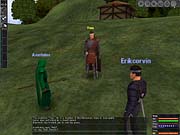
Though it won't be the only thing to do in the game, fighting will be an important part of Dark Age of Camelot. All of Dark Age of Camelot's combat takes place in real time, and it is surprisingly complex, because it takes your character's (and your enemy's) armor, weapons, combat skills (both offensive and defensive), and magic spells and abilities into account simultaneously. Mythic has already implemented many different kinds of enemies, like shifty human bandits, shambling undead, fierce woodland animals, and otherworldly demons. It's already apparent that single combat is strategically very different from party combat and that party combat can differ greatly depending on your party's composition and its battle tactics. It's also clear that despite the fact that a well-balanced party stands a much better chance of conquering tougher opponents, Dark Age of Camelot will definitely allow for solo play. However, it's often more dangerous and more time-consuming.
But Dark Age of Camelot won't just be about fighting. The game will include a comprehensive trade-skill system that will eventually let you create any armor or weapon sold by the in-game merchants. In addition, the game will feature numerous quests of varying lengths and rewards. Dark Age of Camelot already features an early build of the quest system, which includes measures that will help ensure that the players who actually initiate a quest will find the necessary information and items they'll need to complete it, without having the items stolen away by competing players. The quest system needs a bit of tweaking, but it's clear that Mythic wants to avoid abuse and is taking steps to that end.
Character Creation and Advancement
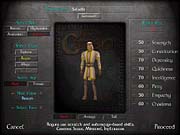
As with many other role-playing games, in Dark Age of Camelot your character's development is described by advancement through experience levels. At the very beginning, your character will begin its life with a rudimentary set of skills (and in the case of mages and acolytes, limited magical powers). However, unlike other such games, in which you may find yourself locked into a single character class from the very beginning, Dark Age of Camelot will let you change your character's profession once it reaches its fifth experience level to a more advanced and specialized character class. With a few exceptions, Mythic has already implemented most of these advanced characters, all of which are interesting and have different skills, spells, and other special abilities, and they may learn more as they gain more experience levels.
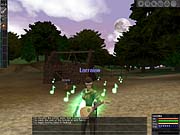
For instance, fighters that have reached level 5 may choose to become one of four classes: the armsman, the mercenary, the paladin, and the yet-to-be-implemented weaponsmith. Paladins are noble warriors whose devotion to their faith compromises their combat ability somewhat, but also grants them the ability to heal and protect their comrades. Armsmen and mercenaries are both powerful fighters in their own right, and even at this early point in the game's development cycle, each is a stalwart and worthy ally in a fight. Armsmen may wear heavier armor at relatively lower levels, which helps their defense immensely and makes them ideal for being the focus of an angry monster's attention (rather than a more frail mage or acolyte). Armsmen may also use powerful polearms: two-handed spears and lances that are heavy and slow to swing but that deliver a great deal damage to enemies. On the other hand, a mercenary's defense is curtailed because heavier armors aren't available until higher levels, though mercenaries may learn the powerful dual wield skill, which lets them attack their enemies with a weapon in each hand. And unlike the more straightforward warrior classes in other role-playing games, both mercenaries and armsmen are able to learn different fighting styles that can deal extra damage or have other effects in combat. Many of these are most useful in the thick of battle, to respond to either a blow dealt or a swing missed.
The other three base classes may also change into more advanced professions. Mages may class-change to wizards or sorcerers. Wizards are experts at wielding powerful elemental magic in battle. They can also deal grievous damage to their enemies and may specialize in a few different magical skills to heighten their prowess. Conversely, sorcerers are generalists: They possess many magic spells that let them weaken, poison, hinder, and take control of their enemies. Rogues may change into scouts, minstrels, and the yet-to-be-implemented infiltrator. Scouts possess stealth skills and may use longbows to attack from a distance, while minstrels use musical instruments to sing songs with continuous magical effects. Acolytes may class-change to the yet-to-be-implemented friar and the cleric, whose skills include healing, protective spells, and attacking the undead.
In terms of its general gameplay balance, interesting character development system, and solid and stable technical performance, Dark Age of Camelot has had a very successful beta test so far. And given the attentiveness of the development team to testers' concerns and the team's brisk pace in producing the game's world and content (Mythic will implement the Norse realm of Midgard in its next phase of beta testing soon), the game looks extremely promising overall. We'll have more coverage on Dark Age of Camelot's progress as the beta continues.
Got a news tip or want to contact us directly? Email news@gamespot.com
Join the conversation